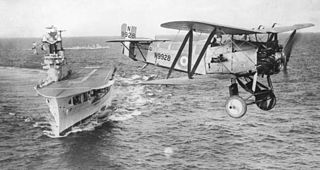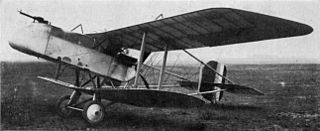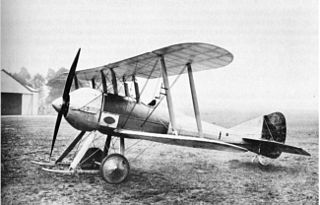
Blackburn Aircraft Limited was a British aircraft manufacturer from 1914 to 1963 that concentrated mainly on naval and maritime aircraft.

A light bomber is a relatively small and fast type of military bomber aircraft that was primarily employed before the 1950s. Such aircraft would typically not carry more than one ton of ordnance.

Between 1911 and 1914, the Royal Aircraft Factory used the F.E.2 designation for three quite different aircraft that shared only a common "Farman" pusher biplane layout.

The Fairey Flycatcher was a British single-seat biplane carrier-borne fighter aircraft made by Fairey Aviation Company which served from 1923 to 1934. It was produced with a conventional undercarriage for carrier use, although this could be exchanged for floats for catapult use aboard capital ships.

The Airco DH.1 was an early military biplane of typical "Farman" pattern flown by Britain's Royal Flying Corps during World War I. By the time the powerplant for which it was designed was sufficiently plentiful it was obsolete as an operational aircraft, and apart from a few examples sent to the Middle East it served as a trainer and Home Defence fighter.

The Armstrong Whitworth A.W.35 Scimitar was a British single-engine biplane fighter aircraft designed and built by Armstrong Whitworth Aircraft. Four Scimitars were produced for the Norwegian Army Air Service and were delivered in 1936.

The Royal Aircraft Factory F.E.8 was a British single-seat fighter of the First World War designed at the Royal Aircraft Factory. It could not escape the drag penalty imposed by its tail structure and was no match for the Albatros fighters of late 1916.

The Nightjar was a British carrier-based fighter aircraft of the early 1920s. It was a modification of the earlier Nieuport Nighthawk fighter produced by Gloster after the Nieuport & General company, which designed the Nighthawk, closed down. Twenty-two were converted, serving with the British Royal Air Force from 1922 to 1924.
The Nieuport B.N.1 was a prototype British single-engined fighter aircraft of the First World War. It was a single-engined biplane intended to replace the Sopwith Camel, but only one was built, being destroyed in a crash. The Sopwith Snipe was built instead to replace the Camel.
The Westland N.1B was a prototype British single-engined floatplane fighter aircraft of the First World War. The first aircraft to be designed by Westland Aircraft, it was a single-engined tractor biplane. Despite good performance, only two aircraft were built, the Royal Naval Air Service operating landplane fighters from ships instead.
The Nieuport & General Aircraft Company Ltd was a British aircraft manufacturer, established during the First World War to build French Nieuport aircraft under licence, which closed down in 1920.

The Royal Aircraft Factory F.E.9 was a prototype British two-seat fighter-reconnaissance aircraft of the First World War. A single-engined pusher biplane of 1917, the F.E.9 had poor performance and handling, and only three were built.

The Royal Aircraft Factory N.E.1 was a prototype British Night fighter of the First World War. A single-engined pusher biplane, it was a development of the Royal Aircraft Factory's earlier F.E.9 fighter, but was not successful, only six being built.
The Royal Aircraft Factory A.E.3, also known as the Farnborough Ram, was a prototype British armoured ground attack aircraft of the First World War. The A.E.3, which was a development of the Royal Aircraft Factory's N.E.1 night fighter, was a two-seat single-engined pusher biplane. Three were built in 1918, but the type was unsuccessful, with no further production ensuing.

The Royal Aircraft Factory S.E.2 was an early British single-seat scout aircraft. Designed and built at the Royal Aircraft Factory in 1912–13 as the B.S.1, the prototype was rebuilt several times before serving with the Royal Flying Corps over the Western Front in the early months of the First World War.
The Royal Aircraft Factory S.E.4a was an experimental British single-engined scout aircraft of the First World War. Four S.E.4a aircraft were built, being used for research purposes and as home-defence fighters by the Royal Flying Corps. In spite of its type number it had little or no relationship to the earlier S.E.4
The Royal Aircraft Factory S.E.4 was a single-engined, single seat biplane designed and built at the Royal Aircraft Factory just prior to the start of the First World War. Intended to be as fast as possible, it recorded a speed of 135 mph (217 km/h), which made it the fastest aircraft in the world in 1914, but no production followed and it was soon written off in a crash.
The Royal Aircraft Factory F.E.3 (also known as the A.E.1 was a British experimental single-engined pusher biplane built prior to the First World War. It was intended to be fitted with a shell-firing gun, but was quickly abandoned, being found to be structurally unsound.
John Kenworthy B.Sc., F.R.Aes (1883–1940) was an English aviation engineer and aircraft designer.
The Royal Aircraft Factory S.E.6 was a proposed single-engined, single seat biplane designed at the Royal Aircraft Factory in First World War.










